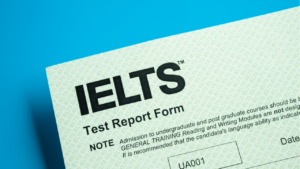In the article, you will find the basics of writing a good Line And Bar Graph IELTS answer with examiner comments. We have also provided the updated vocabulary to write this section along with some tips and tricks for a better score. Students appearing for IELTS need to write a report of 150 words in writing task 1. In this section, candidates are asked to summarize visual information, usually in the form of a chart or graph. A candidate needs to pick out the important details and outline them in the report. As a result, the Line And Bar Graph IELTS require extreme attentiveness, which may be challenging for some students.
There are a few things that are similar to all graphs or charts and other things that make them different. Moreover, the vocabulary in this section is also distinct depending upon the chart or graph that comes in the exam. However, the structure is common for all.

Line Graph & Bar Chart Model Answer
Dual charts are common in IELTS graph writing task 1 academic paper. Describing two charts together is fairly easy if candidates know the strategy. The line graph mentioned below shows visits from and to the UK from 1979 to 1999. On the other hand, the bar chart indicates the most sought-after countries visited by residents of the UK in 1999.

Model Answer:
Crack IELTS Exam in first attempt
Attend Leap’s free masterclass to get tips, tricks and advance strategies to crack IELTS exam in first attempt

The line graph indicates the number of UK residents visiting foreign countries and overseas citizens visiting the UK between 1979 and 1999. On the other hand, the bar chart indicates the most popular countries visited by the residents of the UK. The units in both these graphs are measured in millions. There was an overall increase in visits to and from the UK during the given period. However, the increase in UK residents visiting abroad was higher than overseas residents visiting the UK. Furthermore, residents of the UK visited France the most in 1999, making it the most popular. The number of UK residents visiting abroad was under 15 million in 1979. This figure rose significantly and reached over 50 million in 1999. Moreover, around 10 million overseas residents visited the UK in 1979, which rose to around 30 million in 1999.
Over 10 million UK residents visited France in 1999, followed by Spain, which around 9 million UK residents visited. Greece and the USA had around 3 million and 4 million visitors from the UK. The least popular country that UK residents visited in 1999 was Turkey, with only about 2 million visitors.
Crack IELTS Exam in first attempt

Attend Leap’s free masterclass to get tips, tricks and advance strategies to crack IELTS exam in first attempt
Examiner Comments
The writing task 1 for Line And Bar Graph IELTS reports both a graph and chart organized into rational paragraphs. The candidate has introduced both charts in the introduction, and the following parts contain a detailed overview of the key features of the chart. The writer has used the correct language for the line graph, and there are varying sentence structures throughout the piece.
Bar Chart
A bar chart or a bar graph is a horizontal or vertical bar representing data compared to various categories of variables. These bars are indicated on X-axis or Y-axis with assigned numerical values shown by the height or length of rectangular shapes or identical widths.Here are a few tips for writing well on a bar chart:
- Focus on the data clearly. Figure out which bar is the lowest and which is the highest, and then start writing.
- Do not mention each and every bar in the report.
- Include each and every variable in the report
Line Graph
A line graph illustrates the change of data over time. Similar to bar charts, data in a line graph is also depicted on the X-axis and Y-axis. The X-axis consists of the time period, and the Y-axis measures the variable shown.Here are some tips and tricks to write well for the line graph IELTS task 1:
- Decide the trend of the flow through the head of the line.
- Here, the minimum and maximum points can be figured out by looking at the starting of the line and its ending. It will indicate the place from where the line started and where it is headed towards.
- The first paragraph can describe the minimum and maximum line points.
Differences Between a Bar Chart & Line Graph
There are a few differences between Line And Bar Graph IELTS that candidates appearing for this exam must know.
| Bar chart | Line graph |
|---|---|
| A bar chart contains bars with different lengths. | A line graph consists of various points connected to a single straight line. |
| Major figures are known to the reader. | Even the smallest trend is clear in a line graph. |
| Candidates can know more variables in a clear way. | 2 or 3 variable trends are more suitable. |
Pie Charts
Pie charts are circular shaped figures that are divided into various sectors indicating different percentages. These sectors form a full circle. The more the area of a sector, the greater the percentage. A pie chart is usually not used in technical or scientific sectors.Here are a few tips and tricks that candidates can apply on band 9 samples to score better on the writing task 1:
- Focus on the least and major sections of the pie chart.
- Ignore over-complication of the percentages by mentioning them in figures.
Vocabulary for These Charts & Graphs
It is crucial to use the perfect set of vocabulary to describe flow charts IELTS task 1, or bar graphs, line graphs, and pie charts. Vocabulary enhancement will indicate that the candidate has a steady grip over the language and knows how to indicate certain figures. Mentioned below is the vocabulary that one should use for Line And Bar Graph IELTS.
Vocabulary for IELTS Bar Graph
- Provides information on/about
- Illustrates
- Indicates
- Shows
- Compares
- Explains why
- Draws the conclusion
Vocabulary for IELTS Line Graph
- Peak points, upward, constantly increasing, upsurge, inclining, burgeoning
- Lowest points, declining, gradually decreasing, downward
- Zig zag trend, changes, variations, fluctuations
Vocabulary for IELTS Pie Chart Percentages
- 10% – a tenth
- 20% – a fifth
- 25% – a quarter
- 33% – one third or a third
- 40% – two fifth
- 50% – a half
- 67% – two-third
- 75% – three fourths
- 100% – a whole
Tips for Writing the Report in IELTS Writing Task 1
When you write a report for a table chart IELTS, keeping a few pointers in mind can help secure a good band score. Here are a few tips that might help candidates ace the Line And Bar Graph IELTS test:
Tip 1: Understand the structure
To write an effective report concerning the flow chart IELTS, bar graph, or pie chart, one needs to fully understand the structure of the report. It is advisable that candidates distribute the entire report into the following sections:
- Introduction to the chart/graph
- Provide an overview
- Give a description of the important features
- Provide a short conclusion
Tip 2: Understand the question properly
Candidates must understand how they are marked in this section of the test. The final score ranges between 1 and 9. The criteria for this assessment are as follows:
- Vocabulary accuracy and range – 25%
- Task achievement – 25%
- Coherence and cohesion – 25%
- Grammar accuracy and range – 25%
It is evident that for a better score in writing task 1, candidates need to focus on all the above-mentioned criteria and make sure they are confident with their language.
Tip 3: Managing the time right
Time management is one of the most important aspects to score well in an exam. Some candidates take too long to complete the table graph IELTS that they don’t have much time to answer the other questions. Candidates must certainly practice completing task 1 in 20 minutes and not stretch it for more than 25 minutes. For proper time management, one needs to solve model questions while clocking their answers.
Tip 4: Evaluate the difference between each task
All tasks in the Line And Bar Graph IELTS are not the same. There are some variations in questions that candidates need to evaluate clearly. For instance, students need to draft out comparisons using percentages for pie charts, whereas for processes, passive voice usage is imperative.Students failing to get this right will lose a lot of marks.
Tip 5: Practice by example
Practice pie charts, bar graphs, line graphs, or flow chart IELTS with various study materials available online. Candidates can search the internet to find some valuable model questions with their answers to pick up on the vocabulary that these graphs and charts use.

Conclusion
To crack IELTS, candidates need to overcome the myths surrounding this exam. With a systematic approach toward the Line And Bar Graph IELTS, one can score well in the writing task 1 section. Moreover, as writing is one of the toughest sections in IELTS, candidates need regular and rigorous practice to achieve a firm grip over it. Apart from that, following the tips mentioned above ardently will also help you tackle this section with comfort. Furthermore, aspiring students planning their study abroad program may also require additional funding, as immigrating to a foreign country is a costly affair. To fund your studies in a hassle-free way, you can approach Leap Scholar. Our financial products are crafted for ambitious students who aim to chase the best international education.
Frequently Asked Questions
1. Can I retake IELTS Writing?
Ans: No, individual sections of IELTS cannot be retaken. If you wish to improve the score, you will have to retake the whole section, including four sections.
2. How is IELTS Writing Task 1 marked?
Ans: IELTS Writing task 1 is marked based on four criteria: Grammatical Range and Accuracy, Lexical Resource, Coherence and Cohesion, and Task Achievement. Each criterion constitutes 25% of the total marks.
3. Can IELTS Writing Test be taken through the computer?
Ans: Yes, IELTS is available in two formats: Computer and paper-based. Those with a fast typing speed can opt for it.






